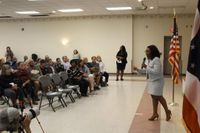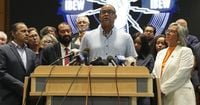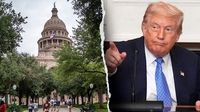On August 20, 2025, the Texas legislature ignited a political firestorm by voting to redraw its congressional map, handing Republican candidates a significant advantage ahead of the 2026 U.S. House of Representatives elections. The move, orchestrated at the behest of President Donald Trump, aims to secure at least five additional Republican seats in Texas—a shift that could tip the balance of power in the House. But the ripple effects of this partisan maneuver have reached far beyond the Lone Star State, sparking a fierce and unprecedented response from California and stirring anxieties in battleground states like Ohio.
California’s answer was swift and bold. Within a day, Governor Gavin Newsom signed a bill to create a special November 4, 2025, election for Proposition 50. The measure asks voters to approve the creation of up to five new Democratic-leaning districts, effectively countering Texas’s redistricting gambit and extending the impact through the 2030 election. "It’s not just about California," Newsom declared at a press conference. "It’s about the United States of America."
Proponents of Proposition 50 argue that the measure is a transparent, voter-driven response—a stark contrast, they say, to Texas’s legislative approach. California, which typically relies on an independent commission to draw its district maps, is asking voters to temporarily suspend that system for three election cycles. According to a recent Democratic Party poll, 57% of Californians now support Proposition 50, up six points from July, while 35% oppose it and 8% remain undecided.
Yet not everyone is convinced this is the right path. During a heated assembly debate, Minority Leader James Gallagher, who represents parts of Butte County, invoked biblical warnings and cautioned against escalating the partisan battle. "You move forward fighting fire with fire and what happens? You burn it all down," Gallagher said. He continued, "If there is one weakness that we have right now in our republic, it is that legislators are not standing up to executives of their own party."
Democratic State Senator Scott Wiener, representing San Francisco, echoed the gravity of the moment but defended the process. "None of us wanted to be here. Politicians shouldn’t draw the maps that determine how people get represented," Wiener wrote in an email. "But what’s happening now is simply unprecedented. We are facing a grave threat to our democracy. But unlike President Trump and Texas’s Republican leaders, we aren’t making the decision for you. All we are doing, all we’re able to do under California’s Constitution, is draw up a proposal and put it on the ballot for you, the voters, to decide."
The stakes are especially high in places like Chico, where redistricting could upend the political landscape. The proposed new map would dilute the conservative stronghold of U.S. Representative Doug LaMalfa’s 1st Congressional District by shifting in more liberal voters from the Napa-Sonoma area and Santa Rosa. Similarly, Kevin Kiley’s 3rd District would become more favorable to Democrats by incorporating liberal parts of Sacramento County, while the Sierra Nevada section would move to Republican Tom McClintock’s 5th District.
Republican incumbents are pushing back hard. In a July 25 press release, LaMalfa, Kiley, and the state’s other seven Republican House members blasted the proposal. "It’s a shame that Governor Newsom and the radical left in Sacramento are willing to spend $200 million on a statewide special election, while running a deficit of $20 billion, in order to silence the opposition in our state," they stated. The delegation pledged to "fight this redistricting effort by whatever means necessary to ensure the will of the people continues to be reflected in redistricting and in our elections."
The battle for public opinion is already fierce. On the day Newsom signed the bill, opposition flyers funded by a $10 million donation from Charlie Munger, Jr. began arriving in Chico mailboxes, falsely suggesting the League of Women Voters opposed Proposition 50. The League quickly issued a statement: "You may have received a mailer from ‘Hold Voters Accountable’ about the redistricting ballot initiative this November. By naming our organization and quoting Gloria Chun Hoo, the mailer wrongly implies that the League of Women Voters of California is part of their coalition and endorses the information contained in the flyer. This implication is not correct—we are not part of that coalition. The League of Women Voters of California did not authorize this action."
On the other side, the "Yes on 50" campaign has been buoyed by an endorsement from President Barack Obama and more than $9 million in donations from Democratic and labor groups, including the House Majority PAC, Governor Newsom’s leftover campaign funds, SEIU, and philanthropist Bill Bloomfield.
Meanwhile, the reverberations of redistricting are being felt across the country. In Ohio, about 200 residents gathered at a union hall in Canton on September 2, 2025, to hear from Democratic U.S. Representative Emilia Sykes. With Ohio lawmakers set to redraw the state's congressional map later this year—after the previous map was passed along party lines—Sykes knows her 13th District seat is in the crosshairs. "I have always been the apple of the eye of the Republicans in this congressional seat," Sykes told the crowd, noting that her last two campaigns have cost nearly $50 million. She and fellow Democrat Marcy Kaptur, who both represent toss-up districts, are prime targets for Republican mapmakers aiming to bolster their party’s chances in 2026.
Sykes recounted how, under the previous map, cities like Canton and Akron were split among five lawmakers, none of whom lived locally. "This district was the outskirts of all of their districts, so we got what was left over in terms of their time, their attention, the resources they were willing to send here, and it showed," she said.
She also discussed her anti-corruption legislation, which would make it harder for officials to accept gifts, and highlighted her role on the Science, Space and Technology Committee—an assignment that helped Akron secure a tech hub and gave her oversight on the Intel project in Licking County. Sykes criticized Vice President JD Vance for labeling Akron and Canton as "lawless" and condemned the Trump administration for pausing community policing and nonprofit security grants.
The town hall wasn’t without controversy. Two attendees interrupted to criticize Sykes for accepting about $180,000 from pro-Israel organizations, then joined protesters outside demonstrating against Israel’s war in Gaza. Other constituents raised concerns about everything from passenger rail to Medicaid. Sykes expressed deep worry about the Republican-backed One Big Beautiful Bill Act, which could jeopardize Medicaid coverage for seniors needing long-term care. Bill Wyss, whose mother with advanced dementia has spent $275,000 in savings and is now approaching Medicaid eligibility, voiced the fears of many: "That’s always been there, but maybe not... we’re gonna be talking about, you know, hundreds of thousands of people maybe who have been in nursing home care of some kind and may be thrown out."
On immigration, Sykes lamented the collapse of bipartisan reform efforts, blaming political gridlock. Jodi Roberts, who sponsored a Ukrainian family under a humanitarian parole program, described the uncertainty facing families whose legal status is now in limbo. "They would like to make a life here," Roberts said. "They would like to put down roots." But with renewal applications met by silence, the future remains unclear.
As redistricting battles intensify from California to Ohio, the stakes for representation, resources, and the shape of American democracy have rarely felt higher. With voters set to weigh in on Proposition 50 this November, and similar fights brewing elsewhere, the outcome will reverberate far beyond partisan lines—shaping not just electoral maps, but the lived realities of communities across the nation.


